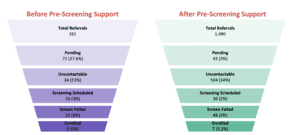Clinical trial participants value consistent engagement from research staff. Knowing they can speak to someone for advice and support is invaluable, from the recruitment phase to the end of the study. But we know it can be difficult for study sites to achieve the level of engagement people want and value.
In a recent webinar, we took a deep dive into how outsourcing this type of patient engagement can improve patient retention and recruitment, and drive efficiencies by freeing up research staff to concentrate on other areas of the study. For this discussion, Kari Reilly, Site Operations Lead for Innovative Trials, was joined by
- Kristin Faber, Vice President of Clinical Trial Patient Recruitment at Spectrum Science
- Gwen Barger, Site Manager for CCT Research, and
- Adel Sepulveda, One of our patient-facing Navigators.
The healthcare model has evolved over the years as people increasingly want and seek an active role in managing their health. Apps and wearables make it easy for people to monitor their health, and care has generally become much more patient-centred.
At the same time, people are interested in contributing to the development of new treatments, but want the process to be as simple as possible and easy to understand.
 “The task for pharma and wider healthcare is to create an infrastructure, which allows people to effectively participate in research without causing huge disruption to their lives,” – John Pinching, Pharma Times Editor.
“The task for pharma and wider healthcare is to create an infrastructure, which allows people to effectively participate in research without causing huge disruption to their lives,” – John Pinching, Pharma Times Editor.
Good engagement with clinical trial patients is crucial for minimizing disruption and enhancing the patient experience. We also know it is vital for continued retention – without the proper support, up to three in 10 participants will eventually withdraw from their study. Increased drop out rates can risk the viability of the entire trial.
But we know this can be challenging for sites to accomplish due to time and resource pressures. Every person who joined our webinar told us they are struggling with patient recruitment and retention in clinical trials.
One solution is to outsource to a specialized provider. Since our inception, Innovative Trials has focused on patient-centric approaches to boost clinical trial patient retention and recruitment, particularly through our global network of Clinical Enrollment Managers and our new Patient Navigators.
This benefits:
- patients, by ensuring they receive consistent support throughout the study,
- sites, by alleviating their burden, enabling them to focus on other aspects of the trial, and
- sponsors, by securing high-quality referrals and improving the ability to retain patients for their clinical research.
Improving clinical trial patient retention
Our ultimate goal is to support clinical trial patients at every stage of their research journey. And one of the ways we can achieve this is to remove some of the burden from sites.
 “We, lead sites to solutions through collaboration,” explained Adel. “We do our best to collaborate with the site to understand the problem and work through it together to find a solution.”
“We, lead sites to solutions through collaboration,” explained Adel. “We do our best to collaborate with the site to understand the problem and work through it together to find a solution.”
This can begin at the prescreening stage. From speaking to sponsors and sites, we know the inevitable influx of referrals from digital campaigns, which are fast becoming a core cog in the patient recruitment process, can be tricky to filter. It takes time to identify high-quality referrals, which is a luxury not all sites have. Ensuring adequate resources are available to manage this workload is crucial to prevent potentially costly delays for sponsors, and maximise the number of patients enrolled in clinical trials.
“One of the fastest growing aids to patient recruitment are media campaigns. With the inclusion of media campaigns come study websites, website pre-screeners and a lot of referrals,” said Kristin Faber from Spectrum Science. “And we all know, unless you’re looking at a study that’s hyper-targeted or in a very rare therapeutic area that sometimes the amount or the volume of referrals that come through on these website pre-screeners can be pretty overwhelming for a site.”

“I think we can all agree that with media campaigns, from a sponsor perspective, one of the most important parts to that campaign is being able to measure the return of investment…When you have all these referrals coming in, if it’s just putting a site underwater and they’re unable to keep up with the updates, they’re unable to tell you…” – Kristin Faber, VP of Clinical Trial Patient Recruitment, Spectrum Science
Our Navigators focus on filtering digital referrals and following up directly with patients within 48 hours. This ensures that both pre-qualified participants and those interested in joining a study are contacted promptly and have a consistent point of contact from that point onwards. We have seen this approach significantly accelerate the ability to pre-screen prospective clinical study participants and reduce the potential for delays in recruitment.

Helping clinical trial participants navigate their research journey
We know that clinical trials can often be a complex landscape for participants to navigate. They may have questions that need answering. There may be appointments or site visits to remember, self-monitoring to complete, devices to set up and so on. Keeping things simple is key.
Adel described some real-life examples where our Patient Navigator support has benefitted patients and made their clinical trials experience easier than it might otherwise have been. In one such case, a participant needed help to straighten out a payment issue,
“I was on the phone with [them] for about two hours,” said Adel. “And that is just what we do. We do not hand out a number and say, ‘Here, call this number’ and I’m done for the day. We go that extra mile.”
Our Patient Navigators are often the linchpin connecting participants to their clinical trial from start to finish. They are a resource to support and educate patients, but most importantly, a listening ear that brings compassion, care and concern.
For Gwen Barger at CCT Research, our patient-facing services have proven invaluable.
 “I have been so grateful for Innovative Trials,” she said during the webinar. “Sometimes protocols and/or the vendors, there’s not a lot of clarity and things aren’t as streamlined as we would hope they would be…there have been some instances where I’ve had to, for instance, contact Adel when I was literally on the phone with a patient for probably two hours trying to get one of their devices to connect to one of the portals.
“I have been so grateful for Innovative Trials,” she said during the webinar. “Sometimes protocols and/or the vendors, there’s not a lot of clarity and things aren’t as streamlined as we would hope they would be…there have been some instances where I’ve had to, for instance, contact Adel when I was literally on the phone with a patient for probably two hours trying to get one of their devices to connect to one of the portals.
“…I was able to find a resource and Adel was there for me and ever since then she’s been able to help and troubleshoot, and she’s assured me to always reach out if we need that support…it’s been really helpful to take that burden off the site.”
In need of tailored, patient-centric solutions to accelerate the recruitment and retention of patients in clinical trials? Contact us to discover how we can transform clinical participant engagement to benefit your studies.
References
- Alexander W. (2013). The uphill path to successful clinical trials: keeping patients enrolled. P & T : a peer-reviewed journal for formulary management, 38(4), 225–227..https://www.ncbi.nlm.nih.gov/pmc/articles/PMC3684189/
